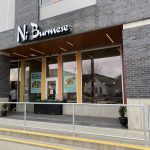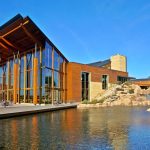Greening our schools
It was a cold November, last year, and I was substitute teaching at Lloyd Street School on Milwaukee’s north side. The “playground” was an asphalt wasteland really, surrounded by nothing but bleakness and a fence. But in the middle of it was a sunken large pit. I stood outside on recess duty, freezing, but it warmed me to watch the children using the soft ground to do double and triple back-flips. It was a gift to see: these children had a bit of earth which made them happy. Moving closer, I noticed small handprints encapsulated in the surrounding concrete. I later learned that this patch of earth was a rain garden and the handprints signified the children’s sense of responsibility for it; it was theirs and they were connected to it.
Education visionary Dr. Maria Montessori once said, “But if for the physical life it is necessary to have the child exposed to the vivifying forces of nature, it is also necessary for his psychical life to place the soul of the child in contact with creation.”
This contact with creation is spreading like wildflowers among schools like Lloyd Street. With rain gardens, greenhouses and the teaching of sustainability, schools are beginning to catch up with Montessori’s 150-year-old advice. Some are calling it the “sustainability movement.”
The heart of this sustainability movement in education is allowing children to observe, hypothesize, try out their ideas, embrace their mistakes and try again. Fostering a sense of independence and confidence when learning to care for the earth is not only healing, but also empowering. It also fosters a sense of community.
Sam White, Associate Dean for Continuing Education at UW-Milwaukee, has noticed that the trend to train students in sustainability is growing quickly, at all levels of schooling. UW-Milwaukee is creating a school for fresh water sciences based on research solutions and development. White said MATC is also building a 30,000 sq ft building to accommodate training of solar panel installers, technicians and pre-engineering students. For a full list of Green degrees visit: www.ci.mil.wi.us/EconomicDevelopment13219.htm
• They help reduce the amount of water that runs off your yard and into the sewer system, cutting down on the risk of sewer overflows and basement backups.
• Rain gardens prevent storm water from picking up pollution as it washes across yards, driveways and parking lots on the way to the nearest river or lake.
• Plants, roots, soils and sand from your garden cleanse and purify storm water as it soaks into the ground.
• Rain gardens can help recharge drinking water supplies and aquifers. They add beauty to your yard and neighborhood while providing valuable wildlife habitat.
MMSD has speakers available to come to any organization for green education. In the fall, the company will release a 20-session lesson plan for schools that teaches all about water.
Rain gardens are not just for those who can afford them. Homeowners and businesses both can apply for grants to help reduce the cost of planting through the Lake Michigan Rain Gardens Initiative at: http://v3.mmsd.com/lmrgi.aspx or www.v3.mmsd.com.
Teachers wanting to plant a rain garden with students can find lesson plans from UW-Madison on the Arboretum web site. Visit: http://uwarboretum.org. Once on the site, search for “rain gardens.” Click on the third entry: “Rain Garden Curricular Sampler.”

Students at Milwaukee’s School for Urban Planning and Architecture on S. 32nd Street work on an aquaponics system inspired by Will Allen’s work at Growing Power.
At the high school level, things get more advanced. Not far from Miller Park, on South 32nd Street, is the School for Urban Planning and Architecture (SUPAR). The school is an MPS high school created in partnership with UW-Milwaukee’s School of Architecture and Urban Planning. Nancy Frank is a SUPAR mentor and UW-Milwaukee Urban Planning faculty member. She said the kids were recently inspired by Will Allen’s Growing Power aquaponics system and set out to create one of their own. The know-how came from the source, Growing Power, and also from Sweet Water Organics (an aquaponic fish farm in Milwaukee). The students enlisted help from volunteers at the Sixteenth Street Community Health Center to build the system which now holds two planting beds, about 80 gallons of water, and 20 healthy perch. SUPAR students won an award from the Great Lakes Constructionist Consortium for their work.
Again inspired by Allen, Frank plans to build a rain garden on top of the playground asphalt, and hopes to plant when the students return to school after summer break. They will grow crops for profit; give back to the school and reward the students for their work. They have grant money to take their rain garden know-how on the road too and will plant one off-campus. They are hoping to work with Walnut Way Conservation Corporation who built the lovely rain garden for Lloyd Street School.
Eventually, Frank has plans for an easy recycling program within the school that will help to lead to recycling more difficult materials in the community. She would like to see them build a greenhouse like the one built by Matt Ray at Fernwood Montessori in Bay View.
Fernwood has cultivated not only great students, but great educators too. Ray teaches a 7th-8th grade classroom but has recently developed curriculum for the entire school. Mentored by Will Allen when Growing Power began in 1996, Ray jokes that he feels like the mayor of Gotham City because he has “the cool red phone” to reach Allen anytime. “I never use it, of course, but I am glad to have it.” For Ray and Allen both, the key to promoting sustainability is developing a sense of community and a network.
Ray says: “It feels so good. Sustainability is all about those wonderful virtues we grew up with; giving without expecting to get back, finding enlightenment even from your mistakes, realizing we don’t have to have the answers, we share the knowledge, record the failures as well as the successes, implement and reflect and do it again. Any religion teaches the ideas of temperance and personal sacrifice, which are key elements to sustainability. We are naturally this way.”
Ray is humorous and deeply passionate about the effects of this kind of education. Having just returned from Northland College near Ashland, Wis., and a week-long conference by The Midwest Regional Collaborative for Sustainability Education, of which he was one of six elementary educators, he is truly excited about creating a “sustainability toolbox model” for educators of all levels, Pre-K to post-graduate.
Ray serves on the Milwaukee Teacher Education Center’s (MTEC) Sustainability Leadership Team and is the only educator who sits on the MPS Green Team. He is seeing across-the-board changes for the entire district, including areas outside the classroom such as Maintenance and Facilities and Food Service. MTEC says on its web site that it hopes “to cultivate and support teacher attitudes, techniques and practices which encourage student understanding of fundamental ecological, environmental, economic and equity issues.”
Mary Beth Driscoll, from Groundwork Milwaukee, says MPS has been talking green projects for years. Her non-profit organization, which is a part of a larger national network under the National Park Service and Environmental Protection Agency, was able to find funds through local partnerships and grants. They enlisted students from the Milwaukee Community Service Corp and Americore to help install the Fernwood garden. They trained the 7th and 8th graders to teach the lower elementary students. Driscoll’s group is excited about getting schools interested in helping take care of the Kinnickinnic River Trail.
Can you measure success through sustainability? Ray thinks so. He says, “If a kid isn’t proficient, you say, ‘Do it again. So long as you don’t abandon it and know a good idea is there, let’s re-work it.’ The task itself will give you the feedback without guilt or pressure because the results are there. This is what working with kids and sustainability is all about: guidance on how to be their own individuals. They have to learn how to be sustainable themselves.”
-Shannon Sloan-Spice






















